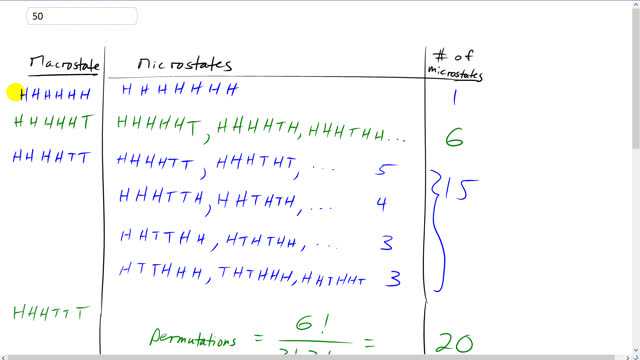
Suppose that you repeatedly shake six coins in your hand and drop them on the floor. Construct a table showing the number of microstates that correspond to each macrostate. What is the probability of obtaining
- three heads and three tails, and
- six heads?
- see video

In order to watch this solution you need to have a subscription.
This is Giancoli Answers with Mr. Dychko. With six coins, they might all be heads, and in which case, there's only one microstate because there's only one way to arrange that in that situation with all heads. And so we have a one here. If you have a macrostate of five heads and one tail, then there are many permutations for that. This tail could be the very last coin or it could be the second last coin, it could be the third last coin, and so on. There are six ways to arrange these coins such they have five heads and one tail. So there are six microstates corresponding to that, this one macrostate. Having two tails, there are a lot of microstates. And in fact, the way to calculate it-- And you calculate it would be to take the number of things. There are six things then divided by the number of duplicates. So there are four heads and there are two tails. This exclamation mark is factorial. So you have six factorial which is a permutation of 6 to six things. And then if you have duplicates, you divide by the number of items in each set. Let's duplicate it. So there's four heads then factorial then times it by two tails factorial. But you can also write out each by hand, each possible microstate. What this will work out to is 15. You could have the four heads here first and then two tails. Or you could have this tail move over one and switch places to this head, in which case you'd have this picture. And if you keep doing that, keeping one tail in the end, you'll have five possible positions for this tail. So one there or there, or there, or there. So, one, two, three, four, five different places for that tail. Or, you could put a head on the end and move just this tail, and there is that one, two, three, four different places for it, and then so on and so on. And end up with 15 possible microstates. For three heads and three tails, it's six factorial divided by three factorial times three factorial. And that gives 20. Two heads and four tails is six factorial divided by two factorial times four factorial, 15. Just as before when you had four heads and two tails. Same idea with four tails and two heads. Six microstates for this macrostate of one head, and then one microstate when you have all tails. So there are a total of 64 microstates. So, what's the probability of three heads and three tails? So we take the number of microstates for three heads and three tails, which is 20. And then divide that by the total of microstates, 64, to get 31 percent as the chance of that happening. And then having all six heads, there is one microstate for that macrostate and so one over 64 is 1.6 percent probability.